Ah, the Newfoundland puppy—such a gentle giant, with a heart as big as their sturdy frame. These majestic canines are not only a symbol of strength and loyalty but also a source of endless joy. As a proud pet parent, you’ll want to ensure your Newfoundland puppy grows up healthy, happy, and well-equipped with the right toys to stimulate their mind and body. In this article, we delve into the world of Newfoundland puppy toys, exploring why they’re crucial and sharing our top picks to keep your furry friend entertained and engaged.
The Newfoundland Puppy: A Majestic Companion
The Newfoundland puppy is an embodiment of majestic companionship, a gentle giant with a heart as big as their bulk. These dogs, known for their gentle nature and unwavering loyalty, are a sight to behold. With their thick, water-repellent coats and expressive eyes, they embody the essence of a loyal protector. As a new Newfoundland puppy enters your life, you’re not just welcoming a pet; you’re welcoming a member of your family.
Their size alone is impressive; they can grow to be over a hundred pounds, with males often towering over six feet at the shoulder. Yet, despite their imposing stature, Newfoundlands are known for their gentle demeanor, making them ideal family pets. They’re patient with children, protective of their loved ones, and known for their ability to fetch heavy objects with ease.
The breed’s origin story is as captivating as their presence. Developed in Newfoundland, Canada, they were originally used as working dogs, pulling boats and heavy loads through the harsh climate. Their strength, intelligence, and resilience have made them invaluable companions over the centuries. Today, while they may not be as hard at work, their gentle spirit remains, making them cherished pets in countless homes.
Newfoundland puppies are more than just large dogs; they are a symbol of loyalty and unwavering dedication. They have a natural instinct to protect their family, and their calm, gentle nature makes them perfect for households with young children. Their playful side is equally enchanting, as they love to romp and splash in water, or simply curl up beside you for a comforting nap.
In terms of care, the Newfoundland puppy requires a balanced diet, regular exercise, and plenty of love and attention. Their thick double coat needs regular grooming to prevent matting and to keep them looking their best. Despite their size, they are quite sensitive and can be easily overwhelmed by harsh discipline or rough handling.
As they grow, it’s important to provide them with toys that not only stimulate their minds but also help to exercise their bodies. Newfoundlands are active dogs and require regular physical activity to stay healthy and happy. Investing in the right toys can make a significant difference in their development and well-being.
Their social nature also means that they thrive on human interaction. They enjoy being included in family activities and can be great at learning tricks and commands. Training should be gentle and consistent, as these dogs are intelligent but may take time to understand complex instructions.
In essence, the Newfoundland puppy is a majestic companion that brings a sense of calm and strength to any home. Their gentle giant presence can be a source of comfort, their loyalty a source of pride, and their playful spirit a constant source of joy. Whether you’re looking for a family pet or a loyal companion, a Newfoundland puppy is sure to fill your life with love and companionship. Their majestic beauty and kindhearted nature make them a truly special addition to any household.
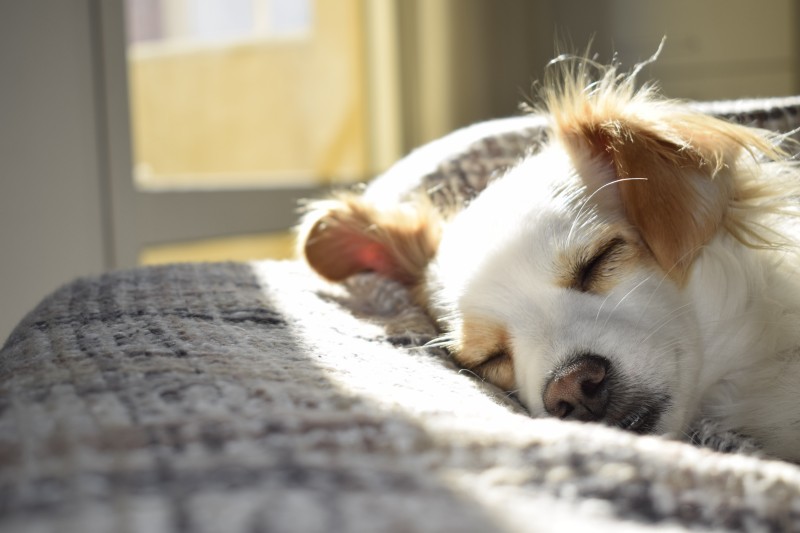
Choosing the Right Toys for Your Newfoundland Puppy
Newfoundland puppies are not just adorable; they are also incredibly energetic and intelligent. As a proud owner of one of these majestic companions, selecting the right toys is crucial for their development, happiness, and well-being. Here are some key factors to consider when choosing toys for your Newfoundland puppy:
The Newfoundland breed is known for its gentle nature and massive size, which means they have a tendency to be quite strong and robust. Their toys should be able to withstand their hearty play. Look for toys made from high-quality materials that can handle the rigors of their playtime.
Size matters, especially when it comes to puppies. An appropriately sized toy is not only safer for your puppy but also more engaging. A toy that’s too small can be easily swallowed, while one that’s too big may not be interesting enough. Ensure that the toy is a good fit for your puppy’s mouth and chewing habits.
Newfoundlands are known for their love of water. If your pup enjoys a good splash in the pool or the lake, consider toys that are waterproof and can float. This way, you can extend their playtime into different environments.
Puppies go through various stages of teething, which can be quite uncomfortable for them. Providing appropriate teething toys can help soothe their gums and reduce the pain. These toys should be soft enough to massage the gums but also durable enough to last through the teething phase.
Engagement is key to keeping your Newfoundland puppy’s mind active and healthy. Look for toys that are interactive, such as puzzle toys that encourage problem-solving or toys that can be filled with treats to keep your pup occupied for longer periods.
Newfoundlands are sociable dogs and thrive on interaction. Toys that can be shared with other pets or even with their human companions can foster bonding and reduce separation anxiety, especially when you’re not at home.
Not all toys are created equal when it comes to safety. Always check for small parts that could be easily torn off and swallowed. Also, avoid toys with strings or loose threads that could pose a choking hazard. Choose toys that have been safety tested and are recommended for young dogs.
Chew toys are a must-have for Newfoundland puppies. These breeds are notorious for their aggressive chewing habits, and providing them with appropriate chew toys can prevent damage to furniture and other household items. Look for toys made from natural materials like rubber or rope, which are less likely to splinter or cause internal injuries.
Your Newfoundland puppy’s playtime should be a mix of fun and learning. Toys that encourage your pup to use their senses, such as those with different textures or sounds, can help stimulate their natural curiosity and improve their cognitive skills.
When introducing new toys, take it slow. Let your puppy explore and investigate the new toy on their own terms. This can help them become familiar with the toy and reduce the likelihood of them becoming overwhelmed or destructive.
Remember, each Newfoundland puppy is unique. What works for one may not work for another. Pay attention to your pup’s preferences and adjust their toy selection accordingly. Some may love plush toys, while others may prefer sturdy chew toys or interactive puzzles.
Lastly, regular maintenance of your puppy’s toys is important. Check them for signs of wear and tear, and replace them if they become damaged. This not only ensures the safety of your puppy but also helps keep their playtime fun and engaging.
By carefully considering the type of toy, size, durability, and safety, you can provide your Newfoundland puppy with the best possible play experience, ensuring they grow into well-rounded, contented dogs.
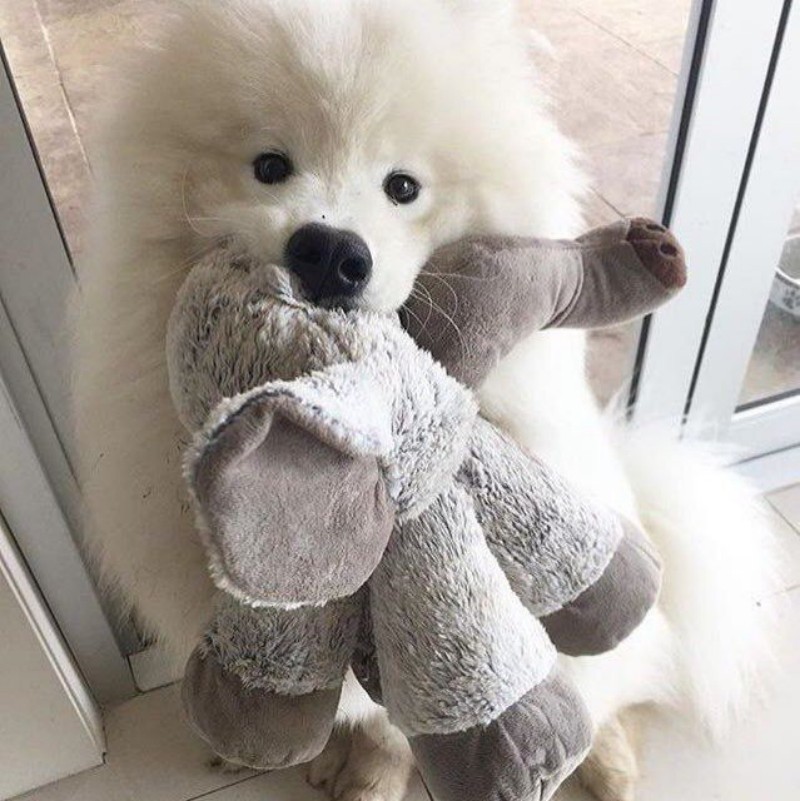
Why High-Quality Toys Are Essential
High-quality toys are not just a luxury for Newfoundland puppies; they are a necessity. These robust and energetic dogs require toys that can withstand their powerful jaws and endless curiosity. Here’s why investing in top-tier toys is crucial for your Newfoundland puppy’s well-being:
Endurance and Durability: Newfoundland puppies are known for their strength and resilience. They have a knack for testing the limits of their toys, often with a fierce determination. A high-quality toy is designed to be durable, with reinforced stitching and sturdy materials that can stand up to hours of rough play. This not only ensures that the toy will last longer but also prevents the puppy from ingesting harmful pieces that could lead to serious health issues.
Mental Stimulation: Puppies, in general, and Newfoundland puppies in particular, are intelligent and require mental stimulation to stay happy and healthy. High-quality toys often come with puzzles, interactive features, or treats that encourage problem-solving and cognitive engagement. This helps to keep their minds sharp and can even reduce the likelihood of destructive behavior due to boredom.
Physical Exercise: The Newfoundland breed is a large one, and they need plenty of physical activity to maintain a healthy weight and muscle tone. High-quality toys, such as tug-of-war ropes or balls that encourage fetch, provide excellent opportunities for exercise. This physical activity is vital for their overall health, helping to prevent obesity, joint issues, and other health problems associated with inactivity.
Teeth and Gum Care: Chewing is a natural behavior for puppies, and it’s essential for their dental health. High-quality chew toys are designed to be safe for puppies’ developing teeth and gums. They can help clean teeth, reduce tartar buildup, and provide relief for teething discomfort. Toys made from natural rubber or durable plastics are often ideal for this purpose.
Safety First: Not all toys are created equal when it comes to safety. High-quality toys are free from harmful chemicals, such as lead and phthalates, which can be toxic if ingested. They are also designed to prevent parts from breaking off and becoming a choking hazard. For Newfoundland puppies, who are more prone to swallowing small objects, safety should always be a top priority.
Socialization and Bonding: Toys can also play a role in socialization and bonding. A high-quality toy can be a tool for interaction between you and your puppy, fostering a stronger bond. It can also be used to introduce your puppy to other pets or children, helping them learn appropriate social behaviors.
Environmental Impact: High-quality toys are often made with sustainable materials and practices, which is not only better for the environment but also for your conscience. Choosing toys that are eco-friendly can set a positive example for your puppy and encourage responsible consumption.
Long-Term Savings: While high-quality toys may seem more expensive upfront, they tend to be more cost-effective in the long run. They are less likely to need frequent replacements, and their durability means they can be passed down to younger siblings or even to adult dogs.
In conclusion, high-quality toys are essential for Newfoundland puppies because they offer a combination of durability, safety, mental and physical stimulation, and the potential for socialization and bonding. By investing in these toys, you’re not just providing entertainment for your furry friend; you’re investing in their health, happiness, and well-being for the long term.
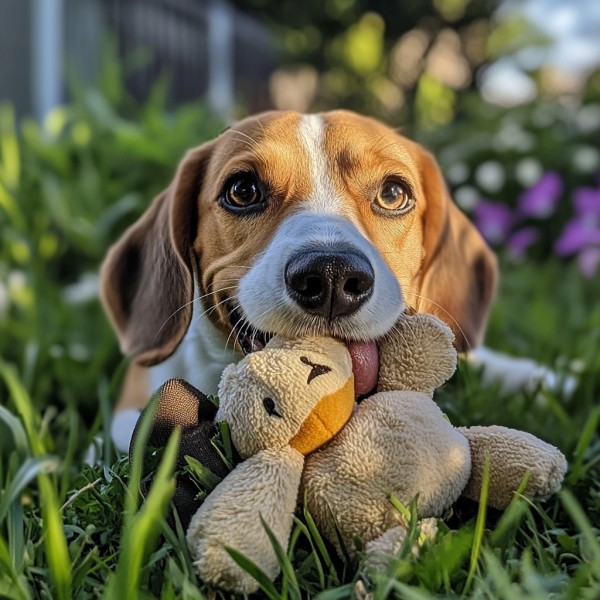
Top 5 Best Toys for Newfoundland Puppies
-
Interactive Treat Dispenser: These toys aren’t just for playtime; they’re also a treat. Designed with puzzle-like features, they keep your Newfoundland puppy mentally stimulated while they work to get their favorite snacks. The durability of these dispensers is impressive, making them a great choice for a breed known for their strength and chewiness.
-
Durable Rope Toys: As a Newfoundland puppy grows, their teething stage can be quite intense. Rope toys are not only gentle on their developing teeth but also resilient enough to withstand their aggressive chewing habits. They are an excellent choice for providing a safe outlet for their natural instincts to herd and pull.
-
Plush Toys with Tug-Resistant Features: Plush toys can be a soothing presence for a Newfoundland puppy, offering comfort during rest or play. Look for those with reinforced stitching and durable materials to withstand the inevitable pulling and tugging. These toys can help prevent your puppy from swallowing small pieces or tearing them apart.
-
Nylon Chew Toys for Aggressive Chewers: For Newfoundlands with a penchant for aggressive chewing, nylon chew toys are a must. They are designed to be tough and resistant to chewing, reducing the likelihood of destructive behavior on furniture or shoes. These toys are also great for dental health, helping to clean teeth and maintain healthy gums.
-
Squeaky and Sound-Engaging Toys: Newfoundlands have a reputation for being friendly and playful, which makes toys that engage their sense of hearing a great addition to their collection. Squeaky toys can provide hours of entertainment as your puppy tries to locate the source of the noise, fostering both mental and physical exercise. Plus, the sound can help soothe your puppy during thunderstorms or other loud disturbances.
-
Puzzle Toys for Cognitive Development: While not all toys fall under this category, puzzle toys are particularly beneficial for Newfoundlands. They encourage problem-solving skills and can be tailored to your puppy’s level of difficulty. As your puppy masters each level, their confidence and intelligence can grow, contributing to a well-rounded pup.
-
Dog Sports Toys: Consider incorporating toys that are used in dog sports, such as agility courses or fetch toys. These can be a fantastic way to engage your Newfoundland in physical activity and mental challenges, keeping them active and entertained.
-
Hide-and-Seek Toys: Newfoundlands are known for their intelligence and can benefit greatly from games that stimulate their senses. Hide-and-seek toys, where you can hide treats or toys, can teach your puppy to search for objects and reinforce their tracking skills.
-
Cold Water Floating Toys: With their love for water, a Newfoundland puppy might enjoy a floating toy that they can chase or play with while swimming. These can be especially great during hot summer days when a cool, wet play session can provide relief from the heat.
-
Customized Toys: For a personal touch, consider getting toys customized with your puppy’s name or favorite patterns. This not only makes them more special to your pet but can also be helpful in training, as your Newfoundland might be more inclined to respond to their own name or preferred design.
Remember, the best toys for your Newfoundland puppy will not only entertain but also provide a safe environment for their natural instincts to be expressed. Regularly inspect and replace toys as necessary to ensure they remain safe and fun for your growing companion.
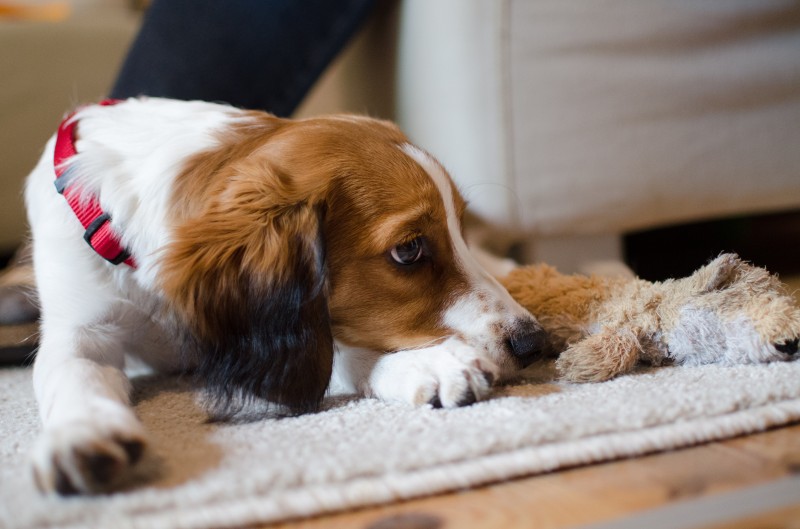
How to Introduce New Toys to Your Newfoundland
Introducing new toys to your Newfoundland puppy is a delightful process that can help in their development and keep them entertained. Here are some tips to ensure a smooth transition:
Find the Right TimeTiming is crucial. Choose a calm moment when your puppy isn’t overly excited or tired. This could be after a meal or a short nap, when they’re in a relaxed state of mind.
Present Toys in a Neutral EnvironmentIntroduce the new toy in a place where your puppy feels comfortable and isn’t distracted by other activities or noises. This could be in their regular play area or a quiet room.
Involve the ScentNewfoundland puppies are scent-oriented, so let them sniff the toy before they play with it. This helps them to become familiar with the new item through their natural sense of smell.
Encourage Play with Positive ReinforcementUse treats or praise to encourage your puppy to interact with the toy. When they show interest, reward them to create a positive association with the toy.
Let Them Explore at Their Own PaceDon’t force your puppy to play with the toy. Give them space to investigate it on their terms. They might need a few moments to understand what the toy is for and how to use it.
Be Patient with ChewingNewfoundlands are known for their powerful jaws and tendency to chew. If your puppy starts to chew on the toy, it’s normal. Just ensure the toy is made from safe, non-toxic materials. Observe their behavior to ensure they’re not ingesting pieces.
Monitor for Signs of DiscomfortKeep an eye on your puppy while they’re playing with the new toy. If they show signs of discomfort, like yelping or stopping play, it might be a sign that the toy isn’t suitable or that it’s too hard.
Introduce Multiple Toys GraduallyDon’t overwhelm your puppy by introducing too many toys at once. Start with one or two and gradually add more as they become comfortable with them.
Keep Toys Clean and SafeRegularly inspect and clean the toys to keep them hygienic. Also, ensure that no small parts can be easily torn off or swallowed, which could be a choking hazard.
Use Toys for TrainingToys can be excellent tools for training. Use them to teach commands or to engage in interactive games that reinforce good behavior.
Avoid Overuse of Electronic ToysWhile electronic toys can be fun, they shouldn’t be the only type of toy your Newfoundland has. These should be used in moderation and not become a replacement for traditional play.
Rotate Toys to Keep InterestTo keep your Newfoundland’s interest piqued, rotate their toys regularly. Sometimes, a toy that has been in storage for a while can become a new favorite.
Be Mindful of Your Puppy’s PreferencesEach puppy is unique. Some may prefer plush toys, while others might be more interested in interactive or chew toys. Pay attention to what your Newfoundland seems to enjoy the most and adjust your choices accordingly.
Stay Involved in PlayEngage with your puppy during playtime. This interaction not only strengthens your bond but also helps in monitoring their play behavior and ensuring they’re safe.
End on a High NoteWhen playtime is over, make sure to end it on a positive note. Praise your puppy for their good behavior and store the toys neatly away so they’re ready for the next session.
Remember, introducing new toys to your Newfoundland puppy is a process that requires patience and observation. By following these tips, you can help your furry friend enjoy their toys safely and develop healthy play habits.

Maintaining Toy Hygiene and Safety
Ensuring that your Newfoundland puppy’s toys are both hygienic and safe is crucial for their well-being. Here are some key points to consider:
-
Regular Cleaning: Toys accumulate dirt, bacteria, and even mold over time, especially if they are chewed on. It’s important to clean your puppy’s toys regularly. Soft toys can be hand-washed with mild soap and water, while harder toys can be cleaned in the dishwasher or with a damp cloth. This helps to prevent any health issues that could arise from bacteria or mold growth.
-
Checking for Wear and Tear: Toys that are worn out or damaged can pose a risk to your puppy. Look for any tears, loose parts, or sharp edges that could cause injury. If a toy is beyond repair, it’s best to dispose of it and replace it with a new one.
-
Avoiding Harmful Materials: Some materials used in toy manufacturing can be harmful to dogs, especially when they are ingested. Be cautious about toys made with small pieces that can be easily chewed off and swallowed, as well as toys that have parts that could lead to choking or internal blockages. Opt for toys made from non-toxic, durable materials.
-
Monitoring Chewing Behavior: Newfoundland puppies are known for their powerful jaws and aggressive chewing. Keep an eye on how your puppy interacts with their toys. If they start to show signs of excessive wear or start to chew on non-toy items, it might be time to introduce a new toy that is more suitable for their chewing habits.
-
Sanitizing Eating Areas: If your puppy’s toys are used for both play and eating, such as puzzle toys or those with treats inside, make sure the areas where they are used are also kept clean. Regularly sanitize the feeding area to prevent the growth of bacteria and parasites.
-
Cleaning after Illness or Accidents: If your puppy gets sick or has an accident, it’s crucial to clean the toys immediately. Use a solution of white vinegar and water or a pet-safe disinfectant to thoroughly clean any toys that may have been contaminated.
-
Storing Toys Properly: After cleaning, store toys in a dry, well-ventilated area. Avoid placing them in damp or humid spots, as this can promote mold growth. It’s also a good idea to rotate toys so that your puppy doesn’t get bored with them and to prevent any particular toy from being overused.
-
Using a Toy Cleaner: There are commercial toy cleaners available that can be used to sanitize toys effectively. These cleaners are designed to kill bacteria and are safe for dogs. Follow the instructions on the product for the best results.
-
Inspecting for Foreign Objects: Periodically inspect your puppy’s toys for any foreign objects that may have become trapped inside. This could be a result of the toy being damaged or your puppy inserting small items while playing.
-
Regularly Replacing Toys: Over time, even the highest-quality toys will show signs of wear. It’s important to replace toys that are no longer safe to use. A good rule of thumb is to replace toys every few months, or sooner if they show significant damage.
-
Educating Family Members: If you have children or other family members who interact with your Newfoundland puppy, make sure they understand the importance of maintaining toy hygiene and safety. This includes proper cleaning techniques and recognizing the signs of a toy that is no longer safe.
By following these guidelines, you can help ensure that your Newfoundland puppy’s toys remain both hygienic and safe, contributing to their overall health and happiness.
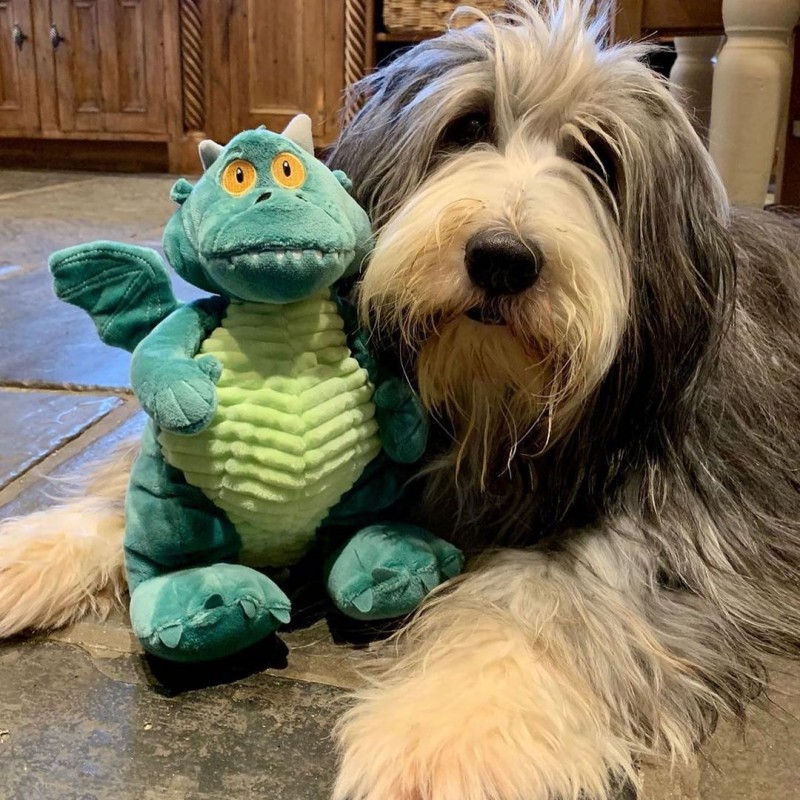
Conclusion: Ensuring a Happy and Healthy Newfoundland Puppy
In wrapping up our journey through the world of toys for Newfoundland puppies, it’s important to reflect on the bigger picture. Ensuring that your furry companion remains happy and healthy is paramount, and the right toys play a significant role in that equation. Here are some key points to consider as we conclude our exploration.
The Newfoundland breed is known for its gentle nature and loyalty, but these majestic dogs also have a playful side that needs to be nurtured. Toys that stimulate their minds and bodies not only provide entertainment but also help in the development of their social and cognitive skills. By the time you’ve read through the following, you’ll have a clearer understanding of how to choose the right toys, introduce them effectively, and maintain their cleanliness and safety.
It’s not just about the joy of play; toys can serve as a crucial part of your Newfoundland puppy’s daily routine. They can help with teething, provide mental stimulation, and even aid in the training process. Here’s a brief overview of the aspects that contribute to a happy and healthy Newfoundland puppy:
- Physical Exercise: Toys that encourage movement and exercise are vital for a Newfoundland puppy’s growth and weight management. These dogs are large and can become overweight if not properly active.
- Mental Stimulation: Puzzles and interactive toys can help keep your puppy’s mind sharp, reducing the likelihood of boredom and destructive behavior.
- Socialization: Toys that allow for play with other pets or humans can help in social development and the prevention of aggression.
- Safety and Hygiene: Ensuring that toys are safe and clean is essential for preventing health issues, such as infections or ingestion of harmful materials.
In the world of Newfoundland puppy toys, there’s a vast array of options, but not all are created equal. Here are some final thoughts on how to ensure your puppy’s toys are a positive addition to their life:
- Material Matters: Opt for toys made from non-toxic materials that are free from harmful chemicals. Natural rubber, plush fabrics, and sturdy plastics are often the best choices.
- Size and Shape: Consider the size and shape of the toy to ensure it’s appropriate for your puppy’s mouth and play style. A toy that’s too small could be a choking hazard, while one that’s too large might not stimulate play as effectively.
- Durability: Newfoundlands are known for their strength and can be quite rough with their toys. Choose toys that are built to last, with reinforced stitching and sturdy construction.
- Regular Inspection: Regularly check your puppy’s toys for signs of wear and tear. If a toy is damaged, it’s best to dispose of it to prevent any potential harm to your pup.
- Cleaning Routine: Establish a regular cleaning routine for your puppy’s toys. This helps maintain hygiene and can prevent the buildup of bacteria or mold.
- Variety: Offering a variety of toys can help keep your Newfoundland engaged and interested. Rotate toys to prevent your puppy from getting bored with the same items.
In conclusion, the right toys for a Newfoundland puppy can be a game-changer. They are more than just playthings; they are tools for growth, learning, and happiness. By thoughtfully selecting toys that cater to your puppy’s needs and ensuring they are well-maintained, you’re setting the stage for a fulfilling life together. Remember, a well-exercised and mentally stimulated Newfoundland is a happy Newfoundland. So, keep exploring the world of toys, and enjoy the journey with your loyal companion.
